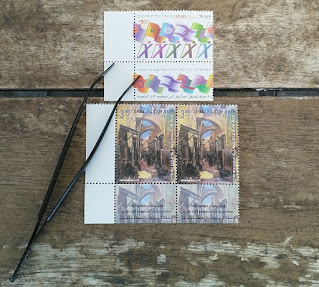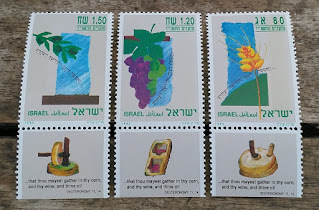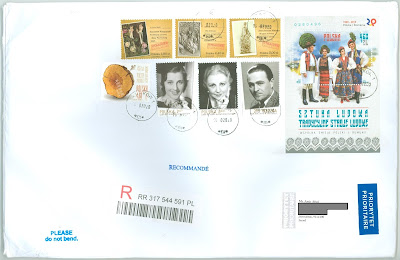Case in point: Had it not been for social media -- specifically YouTube, and more specifically Graham Beck's Exploring Stamps channel -- this blog would likely not have come into being. Rather than develop into a public passion, collecting stamps would have remained a private and sporadic pursuit. What Graham Beck did, which was nothing short of groundbreaking, was expand the definition of "stamp collector" to include a new offshoot identity or sub-identity, namely, stamp explorer. The reason this was groundbreaking was because, in its most reductive sense, "stamp collector" describes a person who spends hours of his free time alone in a room filing away tiny pieces of paper with designs on them in storage albums. The identity that Exploring Stamps projected was in many ways an antithesis of that image: a stamp collector who is collaborative, outgoing, adventurous, innovative, energetic, and hip.
 |
| Philately. Lately. – A website about stamps |
Topics covered on Philately Lately run the gamut from cheerful and lighthearted (Easter eggs, the Smurfs) to somber and serious (Kafka, the Holocaust). That range also applies to the contents of the Krakow-Jerusalem letter. It arrived with stamps featuring children's drawings and kites on the one hand, and stamps commemorating the Jews' expulsion from Spain and the end of World War II on the other. Rather than present the contents here by year or by topic, which is how stamps are typically presented, they are arranged primarily by designer. The motivation for this is purely personal preference -- to give designers, especially those whose names recur often in Israel's stamp catalog, more recognition and to highlight any stylistic features that might be unique to a particular designer. The first stamp, however, is an exception to this format:
 |
| בול לא לגזענות "No to Racism" stamp Israel Post (1986) |
"No to Racism" was an initiative of Amnon Rubinstein, at the time Israel's minister of communications, and he conceived it as a response to the ideology of Rabbi Meir Kahane, whose party Parliament and the Supreme Court would ban in 1988.1 Of relevance to postal historians, 1987 saw the same Amnon Rubinstein successfully motion to revoke Rabbi Kahane's parliamentary privilege of mailing official letters postage-free after letters he sent out were found to contain threatening language.2
1986 was the year Israel, in a fierce battle against hyperinflation, changed currencies from the shekel to the new shekel. The change explains why one of the last stamps issued in 1985 had a face value of 600 shekels while the first stamps of 1986 had face values of 0.01-0.50 new shekels (₪). In the course of communicating with Octavian, it became clear he wished to send stamps that were valid for postage -- presumably, in a pay-it-foward spirit, so that the stamps would be used to send out letters and not live out their days hidden away in a stockbook. "No to Racism" was launched with the fifth round of new issues in 1986, making it one of the first stamps to bear a face value in new shekels and one of the oldest Israeli stamps still valid for postage today.
 |
| אד ואן אויין Ad van Ooijen |
 |
| יגאל גבאי Igal Gabay |
 |
| חיימי קיבקוביץ Haimi Kivkovich |
 |
| משה פרג Moshe Pereg |
 |
| אסף ברג Asaf Berg |
 |
| יצחק גרנות Yitzhak Granot |
 |
| דויד בן־הדור David Ben-Hador |
 |
| גיל פארן Gil Paran |
 |
| רותי קנטור Ruti Kantor |
 |
| דרור גוטליב Dror Gotlib |
 |
| אשר קלדרון Asher Kalderon |
 |
| עיצובי בעל ואישה Husband and wife duos |
 |
| רות בקמן מלכא Ruth Beckman Malka |
 |
| מריון קודנר Marion Codner |
 |
| דניאל גולדברג Daniel Goldberg |
 |
| דני זילברמן Danny Zilberman |
 |
| MVTM; Molcholand |
 |
| Polskie Abecadlo Polish Alphabet |
Much of the appeal of stamps, even to those who don't actively collect them, is their artistic quality. If they were large enough to frame and hang on a wall, that is where many stamps would end up. What aren't nearly as appreciated are the envelopes to which stamps get affixed -- which is why historically stamps have usually been soaked off and the envelopes bearing them discarded. There are instances, however, where stamps on an envelope form part of a larger composition and the envelope, or "cover," constitutes no less of a work of art than the stamps affixed to it. In these instances, the stamp designers deserve credit for their artistic creativity and the stamp affixers merit appreciation for carefully selecting and arranging their stamps and turning a plain white envelope into a uniquely memorable cover. "Krakow-Jerusalem" is such an instance: beyond filling it with dozens of meaningful stamps, Octavian of Philately Lately made it a cover that will long be admired and cherished.


No comments:
Post a Comment